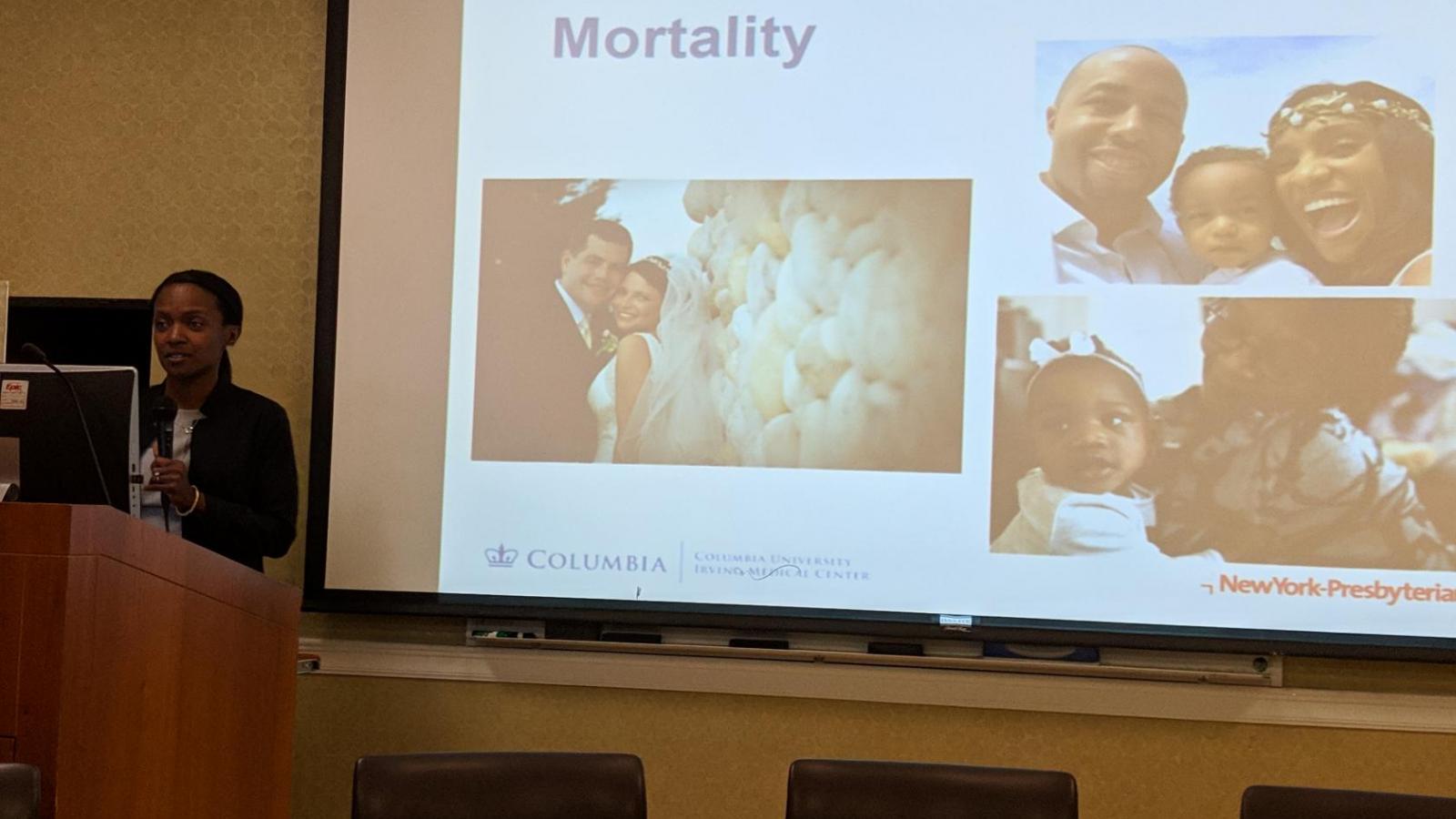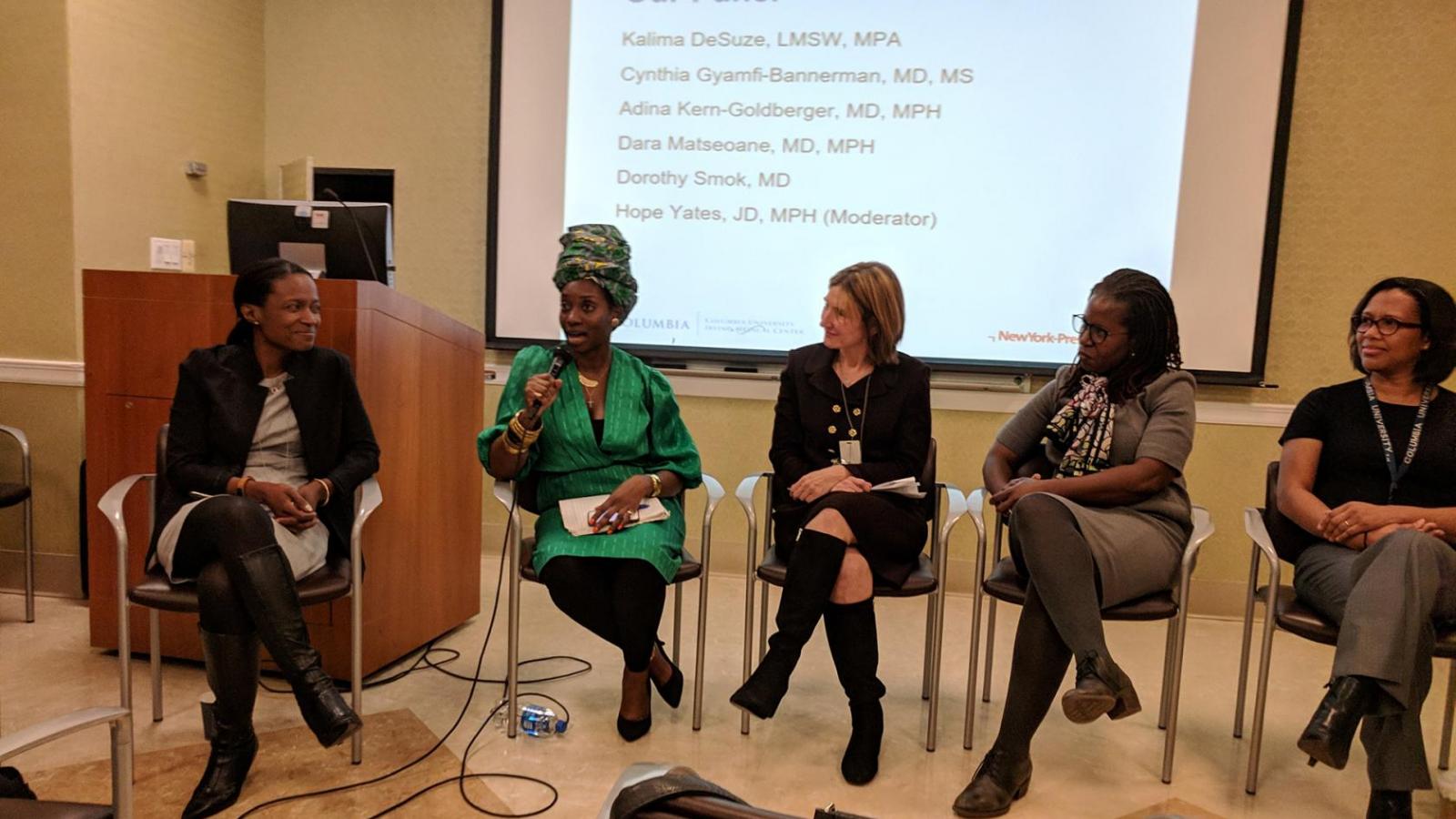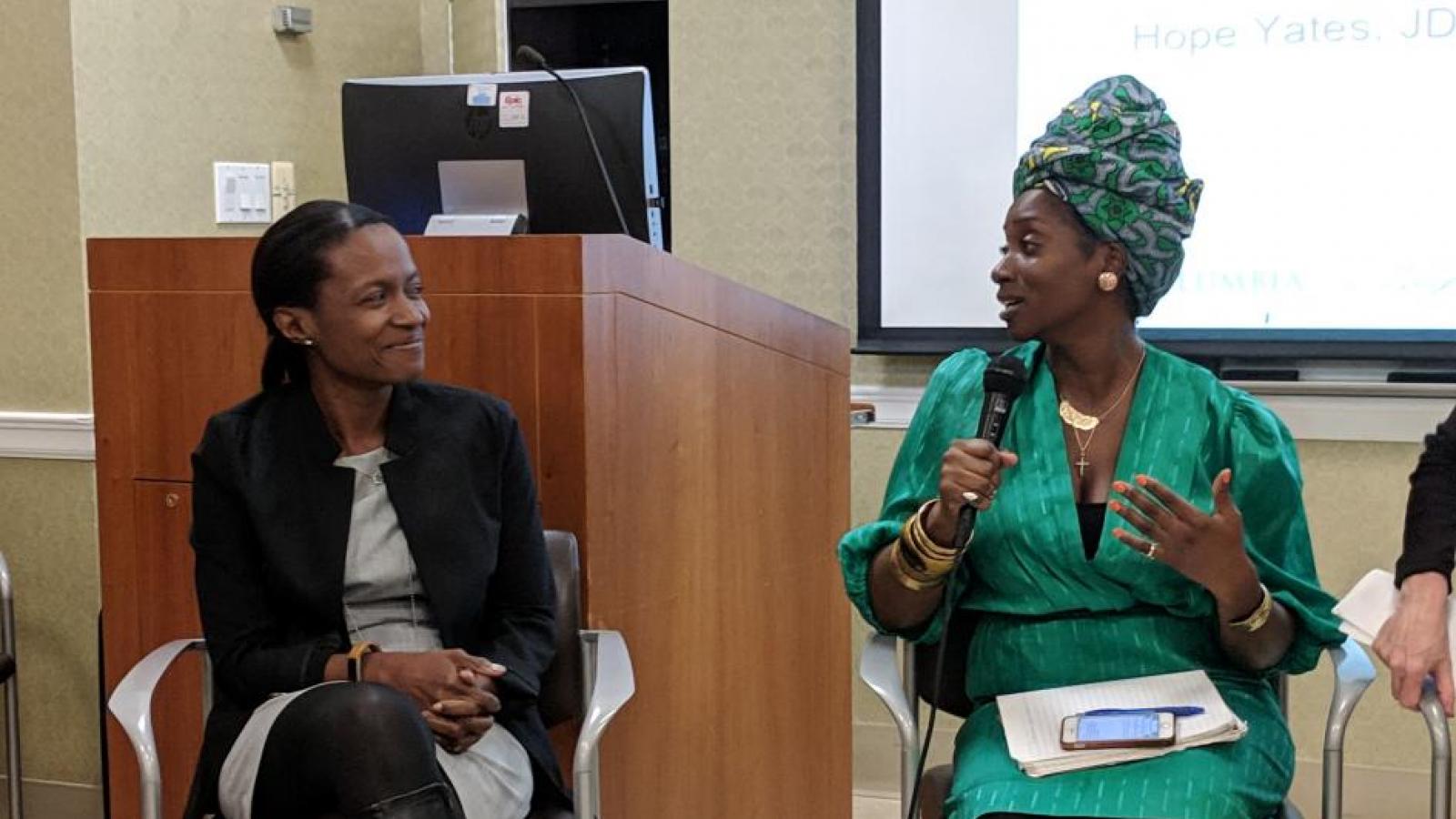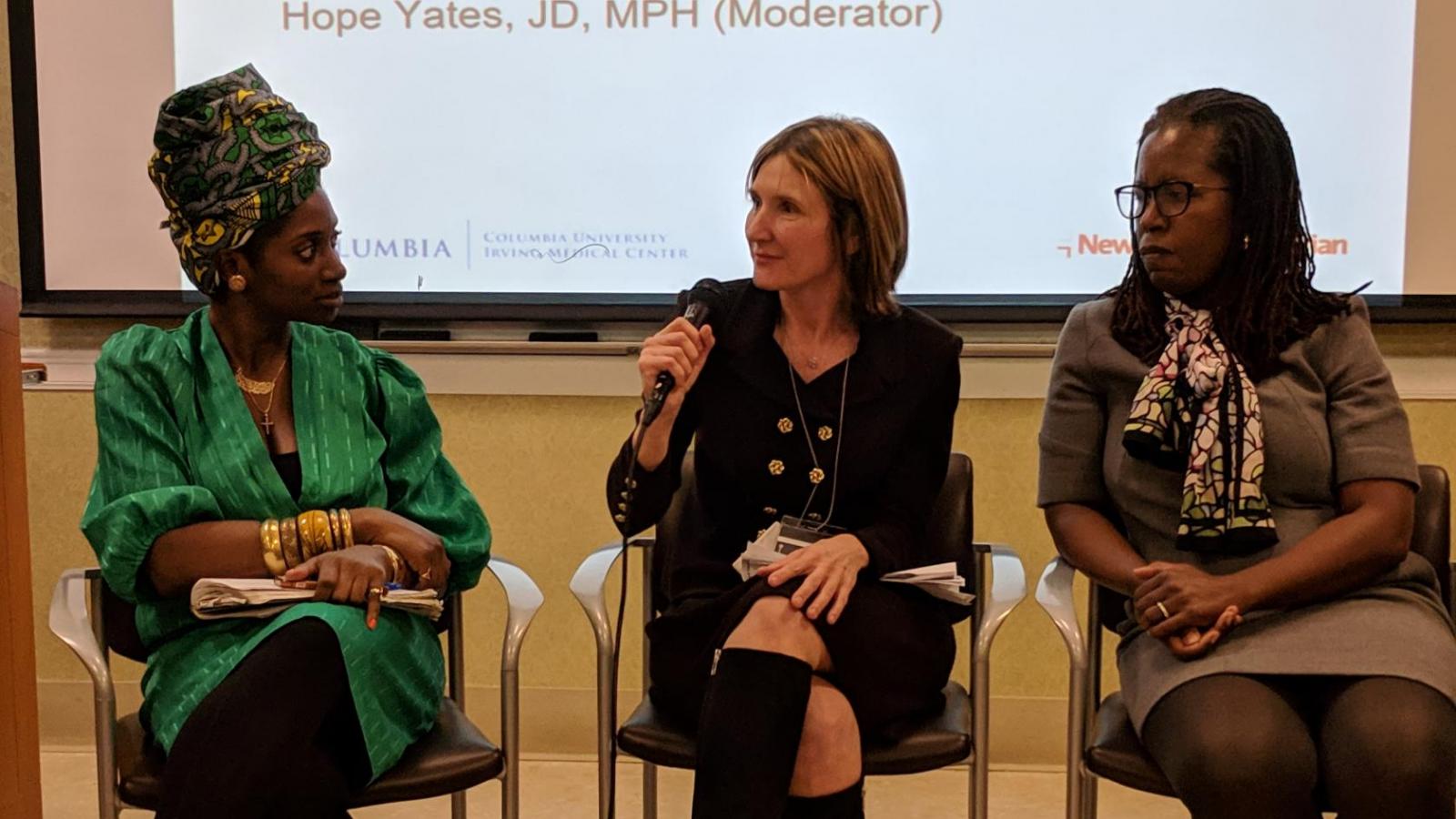Panel addresses racial disparities in obstetric outcomes and the role of race in women's health
Rates of maternal mortality and morbidity in the United States are the highest among similar high income countries, and rates continue to rise. For women of color and especially African-American women, however, the rates of maternal mortality and morbidity are disproportionately higher, with 40 deaths per 100,000 live births for black women versus 12.4 deaths per live birth for white women.
The Department of Obstetrics and Gynecology at Columbia University Irving Medical Center convened a panel of experts to discuss the role of race in women’s health, specifically racial disparities in obstetric outcomes, as part of Columbia University’s Program in Women and Children’s Bioethics Seminar Series. The panel included Cynthia Gyamfi-Bannerman, MD, MSc, a maternal-fetal medicine specialist and the Ellen Jacobson Levine and Eugene Jacobson Professor of Ob/Gyn at CUIMC; Dr. Gyamfi-Bannerman’s former patient Kalima DeSuze, LMSW, MPA, a writer, activist, social worker, and lecturer at Columbia’s School of Social Work; Dorothy Smok, MD, a maternal-fetal medicine specialist with a focus on ethics at CUIMC; Janice Aubey, MD, Director of Postpartum at NewYork-Presbyterian/CUIMC; Dara Matseoane-Peterssen, MD, MPH, Chief of General Ob/Gyn at NYP the Allen Hospital; and Adina Kern-Goldberger, MD, a fourth-year Ob/Gyn resident at CUIMC. The panel was moderated by Hope S. Yates, JD, MPH, Director of Strategy and Communication for the Department of Ob/Gyn.
Dr. Gyamfi-Bannerman gave a brief presentation outlining the data showing racial disparities in obstetric outcomes in the U.S., the recent media coverage in ProPublica, The New York Times, and other national publications that have cast a spotlight on the topic, and efforts being made by Columbia University and others to counteract this trend. Dr. Gyamfi-Bannerman also outlined some of the outcomes research she has led investigating racial disparities when looking at postpartum hemorrhage, preeclampsia, and other conditions related to maternal mortality and morbidity.
“We’re now looking at race as a very important variable, and looking at what we can do from a research and clinical care perspective that is race specific,” Dr. Gyamfi-Bannerman said.
“While racial disparities in obstetric outcomes may seem at first glance to correlate to socioeconomic disparities in outcomes, that doesn’t tell the whole story,” Dr. Kern-Goldberger, who has worked with Dr. Gyamfi-Bannerman researching this topic, said. Dr. Kern-Goldberger and Dr. Gyamfi-Bannerman conducted a study this year that examined maternal and neonatal mortality and morbidity only among college-educated women, which showed racial disparities persisted even among this demographic.
“There’s a bias in the literature with the way that the studies have been done, conflating socioeconomic status and education and race, and it’s so clear from our experiences, from the patients’ stories, and from the data, that that’s not true,” Dr. Kern-Goldberger said. “There is an experience of race in medicine and race in encountering the healthcare system that comes with its own unique challenges, totally independent of these other socio-demographic parameters.”
Speaking from the patient side, Ms. DeSuze presented a different perspective from the other panelists. When she received the happy news that she was pregnant, shortly after undergoing a myomectomy surgery, Ms. DeSuze carefully researched her options to find an obstetrician she felt she could trust and could deliver the care she needed, vetting their approach to clinical care as well as their research. When Ms. DeSuze encountered Dr. Gyamfi-Bannerman’s research around racial disparities, she immediately felt that “this was my person.”
Ms. DeSuze shared that as a woman of color with a background working as an activist to curtail gender-based violence, her trust in medical providers is very weak
Even after personally selecting Dr. Gyamfi-Bannerman to care for her during her pregnancy, Ms. DeSuze still found that she had a difficult time trusting her team.
“Racism and systemic oppression interrupts authentic relationship building,” Ms. DeSuze said. “I couldn’t bring myself to have honest conversations because I was in my head about ‘Do people care about me? Are they on my side?’”
Eventually, Ms. DeSuze and Dr. Gyamfi-Bannerman established a warm and trusting doctor-patient relationship, and now Ms. DeSuze said she couldn’t wait to seek Dr. Gyamfi-Bannerman’s care next time she became pregnant.
Building trust between doctor and patient is necessary to overcoming these challenges, according to Dr. Matseoane-Peterssen.
“It really is building a relationship with a patient, and having them learn to trust us, so that we can then support them through this amazing, special time in their life,” Dr. Matseoane-Peterssen said. “Communication is super important, building trust is super important, and so is meeting people where they are. If someone comes in defensive, rather than ignoring it, we need to figure out what’s going on.”
Standardizing care is another important piece to eliminating disparities in outcomes. Because many instances of maternal mortality and morbidity occur after delivery, the American College of Obstetricians and Gynecologists has advanced the idea of the “fourth trimester,” where patients continue to receive care and follow up even after healthy deliveries to ensure they don’t exhibit any warning signs of conditions that can occur post-natally, like preeclampsia.
“We’re trying to increase standardization in terms of our follow-up, and not just leave the patient to be on her own for that six weeks,” said Dr. Aubey. “Most of these changes related to these conditions happen in the first week after delivery. As new moms are discharged within a day or two of delivery, it’s imperative that we create more opportunities for contact in an outpatient setting.”
All participants in the panel acknowledged that while steps had been taken and research had begun, the road to fully addressing racial disparities in obstetric outcomes is a long one. “We have to take a step back and learn about what our own biases are, so that we can be more aware of them when we’re interacting with our patients,” said Dr. Smok, who organized the panel and supports implicit bias training for the faculty.
“The hardest part about implicit bias is that it’s implicit,” said Dr. Kern-Goldberger. “Having situations and structures where we can hear the patient’s perspective on things is so important, because there is so much bias that we encounter on a constant basis that we’re completely unaware of, and structural barriers that we just don’t know exist.”
The panel acknowledged that the challenges moving forward are not insignificant and the barriers to creating change are high, but all agreed that communication, honesty, and trust were the crucial elements and shared a commitment to continuing the dialogue.










